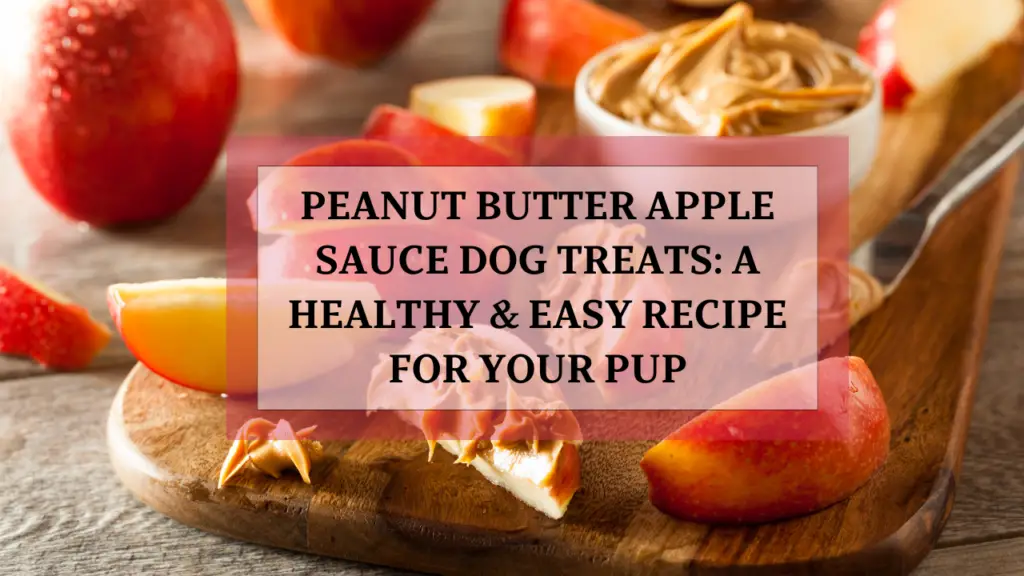As pet parents, we all want the best for our furry companions, especially when it comes to what they eat. Store-bought treats often contain preservatives, artificial flavors, and ingredients we can barely pronounce. By making homemade treats, like peanut butter apple sauce dog treats, you can ensure your pup gets a tasty snack that’s both healthy and safe.
These treats combine the savory richness of peanut butter with the natural sweetness of apple sauce, offering a delightful flavor profile your dog will love. Plus, they’re quick to make, budget-friendly, and packed with nutrients. Let’s dive into why making these treats at home is a fantastic choice for you and your dog.
Peanut Butter Apple Sauce Dog Treat Recipe
Making your own peanut butter apple sauce dog treats is a straightforward process that requires minimal ingredients and equipment. This recipe is perfect for beginners and can be easily customized to suit your dog’s specific needs.
Ingredients Needed
Here’s what you’ll need to get started:
- 1 cup xylitol-free peanut butter
- Choose a natural, unsalted variety for maximum health benefits.
- 1/2 cup unsweetened apple sauce
- Avoid any with added sugars or artificial sweeteners.
- 1 cup oat flour or whole wheat flour
- Oat flour is an excellent gluten-free option, while whole wheat adds extra fiber.
- Optional: 1 egg
- Acts as a binder to help the treats hold their shape.
- Optional: 1/4 cup rolled oats
- Adds texture and additional fiber.
Step-by-Step Instructions
- Preheat Your Oven
- Set your oven to 350°F (175°C) and line a baking sheet with parchment paper to prevent sticking.
- Combine the Ingredients
- In a large mixing bowl, combine the peanut butter and apple sauce. Stir until smooth.
- Gradually add the flour and mix until a dough forms. If the dough is too sticky, sprinkle in a little extra flour.
- Roll Out the Dough
- Lightly flour your countertop or a cutting board. Roll out the dough to about 1/4 inch thickness.
- Cut into Shapes
- Use cookie cutters to create fun shapes like bones, hearts, or paw prints. If you don’t have cutters, simply cut the dough into squares with a knife.
- Bake the Treats
- Place the treats on your prepared baking sheet, ensuring they’re spaced out slightly.
- Bake for 15-20 minutes, or until golden brown. For crunchier treats, bake for an additional 5 minutes.
- Cool Completely
- Allow the treats to cool on a wire rack before serving them to your dog. This prevents burns and ensures the texture is just right.
Baking Tips and Tricks
- Adjust Texture for Your Dog’s Preference
- For softer treats, bake for less time and store them in the fridge.
- For crunchier treats, bake longer and leave them in the oven with the door slightly ajar to cool.
- Portion Control
- Use smaller cutters for smaller dogs to avoid overfeeding.
- Storage Suggestions
- Store treats in an airtight container for up to 5 days at room temperature. For longer storage, refrigerate for up to 2 weeks or freeze for up to 3 months.
Nutritional Information (Per Treat)
Here’s a rough breakdown of the nutritional content based on a standard-sized treat:
| Nutrient | Approx. Amount |
| Calories | 50-60 kcal |
| Protein | 2-3 g |
| Fats | 3-4 g |
| Carbohydrates | 5-6 g |
Why Make Homemade Dog Treats?
Making your own dog treats offers numerous benefits, not only for your pet’s health but also for your peace of mind. Let’s explore why homemade is the way to go:
- Control Over Ingredients
With homemade treats, you decide what goes into your dog’s snacks. This means avoiding harmful additives, preservatives, and fillers commonly found in store-bought options. For instance, the peanut butter apple sauce dog treats recipe uses simple, wholesome ingredients that are completely dog-safe. - Tailored to Dietary Needs
Every dog is unique, and some have specific dietary restrictions or allergies. Homemade treats allow you to customize recipes to accommodate grain-free, low-fat, or high-protein diets. If your dog has a sensitive stomach, you can even use alternative ingredients like pumpkin instead of apple sauce. - Cost-Effective and Sustainable
While premium store-bought treats can be pricey, homemade ones often cost a fraction of the price. Plus, you can make large batches and store them for weeks, reducing waste and saving trips to the pet store. - Quality Bonding Time
Making dog treats at home is also a fun activity that allows you to bond with your pet. Imagine the joy on your dog’s face as they eagerly await their freshly baked snack!
Here’s a quick comparison of store-bought vs. homemade dog treats:
| Feature | Store-Bought Treats | Homemade Treats |
| Ingredients | May contain fillers, preservatives | Fully customizable, no additives |
| Cost | High, especially for premium brands | Budget-friendly |
| Allergen Control | Limited | Easy to adapt for allergies |
| Shelf Life | Long (due to preservatives) | Moderate (can freeze for longevity) |
| Nutritional Value | Variable, often low | High, as per chosen ingredients |
Quote:
“Feeding your pet homemade treats is one of the simplest ways to ensure they’re getting high-quality nutrition without unnecessary extras.” – Pet Nutritionist Dr. Jane Smith
Are Peanut Butter and Apple Sauce Safe for Dogs?
When it comes to treating your pup, safety is paramount. Thankfully, both peanut butter and apple sauce can be excellent, dog-friendly ingredients—when chosen carefully. Let’s explore their benefits and what to watch out for.
Benefits of Peanut Butter for Dogs
Peanut butter is a favorite among dogs and dog owners alike, but it’s not just about the taste. This creamy spread is packed with nutritional benefits:
- High-Quality Protein
Peanut butter is rich in protein, which helps support your dog’s muscles, energy levels, and overall growth. A tablespoon of peanut butter contains approximately 4 grams of protein—a perfect snack-sized boost. - Healthy Fats
The fats in peanut butter are excellent for maintaining a shiny, healthy coat. They also provide essential fatty acids that support brain function. - Packed with Vitamins and Minerals
Peanut butter is a source of essential nutrients like Vitamin E, magnesium, and niacin. These nutrients play a role in immune function, maintaining healthy skin, and metabolizing food into energy.
Important: Always choose unsalted, unsweetened peanut butter without xylitol, a sugar substitute that is toxic to dogs.
Benefits of Apple Sauce for Dogs
Apple sauce provides a natural sweetness without the need for added sugars. Beyond its taste, here’s why it’s a great addition to dog treats:
- Rich in Fiber
The dietary fiber in apple sauce helps regulate digestion, making it particularly useful for dogs with sensitive stomachs. - Low-Calorie Sweetness
Apple sauce is a great way to satisfy your dog’s sweet tooth without adding unnecessary calories. A quarter cup has only about 25 calories. - Loaded with Antioxidants
Apples, the main ingredient in apple sauce, are packed with antioxidants like quercetin, which help reduce inflammation and support overall health.
When selecting apple sauce, always opt for unsweetened varieties. Sweetened apple sauces can contain added sugars, which are harmful to dogs and may lead to weight gain or dental issues.
Ingredients to Avoid in Peanut Butter and Apple Sauce
Not all peanut butter or apple sauce is created equal. Here’s what to steer clear of:
- Xylitol in Peanut Butter
This sugar substitute is extremely toxic to dogs, even in small amounts. Always check the ingredient list, even if it’s a brand you’ve purchased before. - Added Sugars and Artificial Sweeteners in Apple Sauce
Sweeteners like sucralose or aspartame can upset your dog’s stomach and are unnecessary for their diet. - Salt or Preservatives
Excess salt or chemical preservatives can strain your dog’s kidneys and lead to long-term health problems.
Here’s a quick checklist for choosing the right ingredients:
| Ingredient | Safe for Dogs? | Notes |
| Unsalted Peanut Butter | ✅ Yes | Check for xylitol-free varieties |
| Sweetened Peanut Butter | ❌ No | Avoid due to sugars and additives |
| Unsweetened Apple Sauce | ✅ Yes | Natural and healthy |
| Sweetened Apple Sauce | ❌ No | Avoid added sugars or artificial flavors |
Creative Variations for Peanut Butter Apple Sauce Dog Treats
One of the best things about homemade treats is how easily you can adapt them to suit your dog’s taste, dietary needs, or nutritional goals. Below are some fun and functional ways to put a creative spin on the classic peanut butter apple sauce dog treats recipe.
Flavor Variations
- Pumpkin Peanut Butter Treats
- Replace the apple sauce with 1/2 cup of canned pumpkin puree (unsweetened). Pumpkin is rich in fiber and great for digestive health.
- Banana Boost Treats
- Mash a ripe banana and mix it in with the apple sauce for an extra dose of potassium and natural sweetness.
- Carrot-Apple Treats
- Shred 1/4 cup of fresh carrots and fold them into the dough for added texture and a boost of Vitamin A.
Dietary Modifications
- Grain-Free Version
- Swap the oat or wheat flour with coconut flour or almond flour for a grain-free option. Keep in mind, coconut flour absorbs more moisture, so you may need to increase the apple sauce slightly.
- Low-Calorie Treats
- Reduce the peanut butter to 1/2 cup and replace the rest with unsweetened plain yogurt for fewer calories.
- Allergy-Friendly Recipe
- If your dog is allergic to peanuts, use sunflower seed butter or almond butter as a substitute. Ensure it’s unsweetened and xylitol-free.
Fun Shapes and Sizes
- Mini Bites for Small Dogs
- Use tiny cookie cutters to create bite-sized portions that are perfect for smaller breeds or as training rewards.
- Holiday-Themed Shapes
- Use seasonal cookie cutters (like pumpkins, snowflakes, or hearts) to celebrate special occasions.
- Custom Imprints
- Stamp the treats with your dog’s name or paw prints for a personalized touch.
Nutritional Boost Add-Ins
Consider adding these dog-safe ingredients to make the treats even healthier:
| Ingredient | Health Benefit | Amount to Use |
| Ground Flaxseed | Rich in Omega-3s for a shiny coat | 1-2 tablespoons |
| Chia Seeds | Packed with antioxidants and fiber | 1 tablespoon |
| Parsley | Freshens breath and aids digestion | 1 teaspoon, finely chopped |
| Turmeric | Anti-inflammatory and supports joint health | 1/4 teaspoon |
Freezer-Friendly Peanut Butter Apple Sauce Treats
For a cool, summer-friendly twist:
- Mix the peanut butter and apple sauce with plain yogurt to create a creamy batter.
- Pour the mixture into silicone molds or ice cube trays.
- Freeze for 2-3 hours and serve as a refreshing snack on hot days.
Customizing for Picky Eaters
If your dog is hesitant to try new flavors, ease them into it:
- Start by offering small portions as a reward or mixed with a favorite food.
- Experiment with ingredient ratios (e.g., more peanut butter for a stronger scent).
Tips for Safely Feeding Peanut Butter Apple Sauce Dog Treats
While homemade treats are generally safe and nutritious, it’s essential to follow a few guidelines to ensure they’re a positive addition to your dog’s diet. Below, we cover best practices for serving, portion control, and identifying any potential risks.
1. Portion Control: Avoid Overfeeding
Even healthy treats like these should be given in moderation. Overfeeding can lead to weight gain or digestive upset. Follow these general guidelines:
- Small Dogs (under 20 lbs): 1-2 small treats per day.
- Medium Dogs (20-50 lbs): 2-3 medium-sized treats per day.
- Large Dogs (50+ lbs): 3-4 medium or large treats per day.
Tip: Treats should make up no more than 10% of your dog’s daily caloric intake.
2. Watch for Allergic Reactions
Even with natural ingredients, some dogs may have allergies or sensitivities. Monitor your dog closely when introducing these treats for the first time. Common symptoms of food allergies include:
- Itchy Skin or Paws
- Excessive Licking or Chewing
- Digestive Issues (e.g., vomiting or diarrhea)
If you notice any of these symptoms, stop feeding the treats and consult your veterinarian.
3. Be Mindful of Special Dietary Needs
Certain health conditions may require additional considerations:
- Diabetic Dogs: Limit the quantity of treats and avoid high-carb add-ins like bananas.
- Overweight Dogs: Opt for low-calorie variations, such as substituting yogurt for part of the peanut butter.
- Senior Dogs: Ensure treats are soft enough to accommodate dental sensitivities.
Case Study: A study by The Journal of Veterinary Behavior highlights how small, healthy treats can be a valuable tool for positive reinforcement during training, especially in older dogs.
4. Storage Tips to Maintain Freshness
Proper storage is crucial to prevent spoilage and ensure your dog’s treats remain safe to eat:
- Room Temperature: Store in an airtight container for up to 5 days.
- Refrigeration: Keeps treats fresh for 2 weeks.
- Freezing: Freeze for up to 3 months. Thaw portions as needed.
Note: Always inspect treats for mold or changes in texture before serving.
5. Supervise During Feeding
While these treats are designed to be safe, always supervise your dog while they’re eating. This is especially important for dogs that tend to gulp their food, as large treats could become a choking hazard.
6. Use Treats for Training and Bonding
These homemade treats are not just snacks—they’re an excellent tool for training and strengthening your bond with your dog. Use them as positive reinforcement to:
- Teach commands like “sit,” “stay,” or “come.”
- Reward good behavior during walks or grooming sessions.
- Help socialize your dog in new environments.
Quote: “Training sessions with high-value treats create positive associations, which are essential for long-term learning.” — Dr. Karen Overall, Animal Behaviorist
7. Consult Your Veterinarian
When in doubt, always check with your veterinarian before introducing new foods to your dog’s diet, especially if they have existing health concerns or are on a restricted diet.

Hi, I’m Ali Tarek, the founder of Animalsman. I’ve always been passionate about pets, especially dogs and cats, and I created this website to share practical tips, easy recipes, and helpful care advice for fellow pet lovers. My goal is to make pet care simple, enjoyable, and accessible for everyone. When I’m not writing or curating content, you’ll usually find me spending time with my furry friends or learning new ways to keep them happy and healthy.



